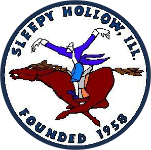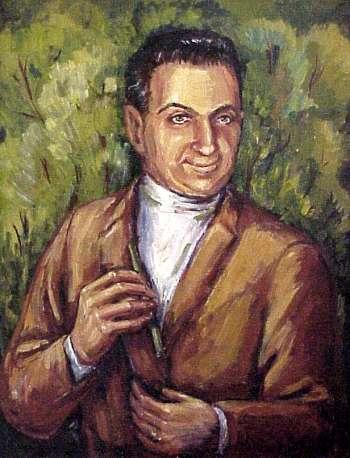
The Dundee Township version of Sleepy Hollow began as a farm. It owes its existence to the vision of a single individual. Floyd T. Falese was a relatively young man of 34 when he bought the Sleepy Hollow Farm west of West Dundee in 1953. Falese was a local resident, a member of Carpentersville’s closely knit Italian-American community. Falese, one of 17 children, was born in Carpentersville on August 6, 1918, the son of James and Theresa Rotunda Falese, who had migrated to America from Calabria, Italy. He never finished high school and was in many ways a classic example of the hard-working, self-made man.
Sleepy Hollow Farm had once been owned by the late J. H. McNabb, board chairman of Bell and Howell Company and mentor of Charles H. Percy, a bright and ambitious youngster, who used to fish on the farm and who later became United States senator from Illinois and chairman of the powerful Senate Foreign Relations Committee. McNabb’s heirs, sold the farm to Mr. and Mrs. Jack Polivka, who sold it in turn to Falese. Falese built a beautiful home there, “Singing Waters,” with two lakes and a waterfall, and moved in with his wife Jacqueline and their two daughters, Paulette and Sharon. He farmed the land briefly, acquired additional properties, and then began subdividing the area to create an upscale housing development that was first marketed as Sleepy Hollow Manor.
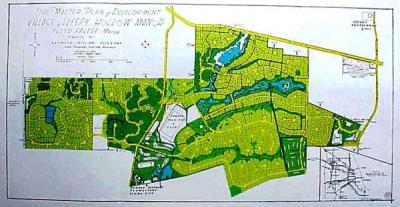
Falese rejected a proposal that the new community be laid out like the usual tract development with neatly gridded streets and sidewalks and rows of look-alike homes lined up with precision like those little green houses on Monopoly boards.
“In the rapid expansion of the suburbs,” he said, “too many areas simply transplanted a city type of housing to outlying areas. They lost the country atmosphere that many people were hungry for when they moved. Houses were hastily built in rows, one on top of another.”
To retain the rural charm and natural contour of the location, Falese retained the services of a prominent planner and landscape architect, Raymond W. Hazekamp, who laid out a pattern of meandering roads, without curbs or sidewalks, that wound into curvilinear cul-de-sacs, avoiding the destruction of a single tree. In addition, spring-fed lakes were dredged and stocked with fish, and Scholz-designed homes were constructed on lots of at least half an acre, the designs carefully selected to enhance what Falese called “the Sleepy Hollow concept of good living.”
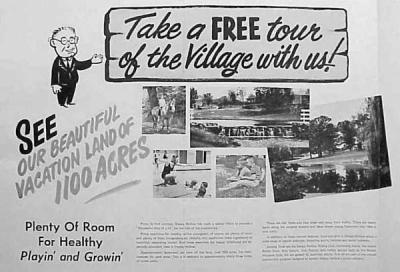
The development obviously was meant to attract relatively affluent residents. As one writer put it, ” …. Falese was advertising his ‘manor’ as a retreat in the country for the common man’s boss.” Recalled an early settler, “It was like a scaled-down version of the Barrington countryside.” The initial development was in the “flats,” the area to the east of Sleepy Hollow Road and bordered on the north by Illinois 72. And most of the first residents were newcomers to the Township, viewed more or less as outlanders by the established population of the Three Towns (Carpentersville, West Dundee, East Dundee). Sleepy Hollow was not accepted in the beginning as in any sense a part of “Old Dundee.”
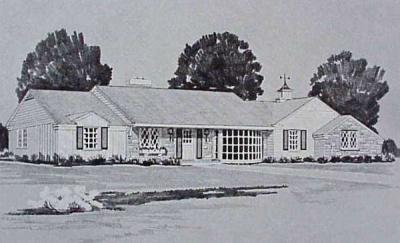
“Falese had a hard time convincing Dundee people they should move out there,” said a long-time resident of the area. “Then gradually that changed when lots were bought by people like Ted and Mary Eichler, Carl and Mariam Hoelzer. People who had roots here. That meant that there’d really be Dundee people out there who accepted it, and Sleepy Hollow maybe was going to become a part of the community after all.” “We bought our lot in Sleepy Hollow in 1955 and started building in 1956,” said Carl Hoelzer (now a Florida resident). “The lot was about two-thirds of an acre and cost the grand sum of $1,500. When we bought 213 Rainbow Drive, all of Sleepy Hollow was unincorporated county property owned or optioned by Falese. It consisted of one main loop road surrounding what was then known as the Suarez property. Our lot was completely devoid of trees or bushes, and all of the land to the north was corn fields and a small stream which afforded many happy hours of bass and bluegill fishing in the summer and excellent ice skating in the winter. Now, after 30 years, our lot looks like a forest, and there isn’t an unimproved lot in sight. I enjoyed the time we lived out there, and only left after all of the kids were grown and away from home.”
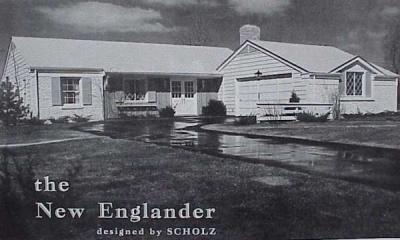
Another move to Sleepy Hollow, in 1961, removed any lingering doubts that the community had indeed been accepted.
Turn back these pages to Irma Dupre’s account of “The Coming of the Oatmans.” It was for the Elder John Oatman, you’ll be reminded, that Mark W. Fletcher laid out the original town of Dundee on the west bank of the Fox River in 1836. Noting that the Oatman line had been carried down here through six generations, Irma wrote half a century ago: “This succession has been represented in Elder John Oatman, his son Jesse and Jesse’s sons, George Frank, and the latter’s son, William Frank Oatman. It is carried on today by William Oatman and his small son, John David.” The aforesaid J. David Oatman, born in 1928, carried on the pioneer tradition of his family when he and his wife Janet moved to 1039 Beau Brummel Drive in Sleepy Hollow on May 15,1961. And that was about as “Old Dundee” as one could possibly hope for.
(Beau Brummel, incidentally, is in this case an amusing corruption of Brom Bones, the burly young suitor in Washington Irving’s tale who ultimately outwitted schoolteacher Ichabod Crane to win the hand of the plump and lovely Katrina Van Tassel. Beau Brummel, or Brummell, was a nickname for George B. Brummell, a famous English fop or dandy who died in 1840.)
“We had heard that Falese was going to open up the hilly area west of Sleepy Hollow Road,” said Janet Oatman. “He was going to put a road in. So we drove up behind the grader to see where the road would go.”
The Oatmans’ reasons for settling in Sleepy Hollow help to explain why the development succeeded, and why Falese selected the location to build on.
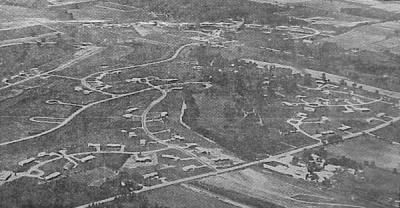
“We wanted a good view,” said Janet Oatman. “And we wanted some acreage. We wanted a wooded lot with a view.” But there were no suitable vacant lots left in West Dundee. The town was almost completely built up, and the area to the west where it might have naturally expanded was totally blocked off at that time by the sprawling D. Hill Nursery. The only solution was to cut loose from Dundee, leap across the nursery, and start a new community in the unincorporated farmland that rolled on to the west, open and inviting. Falese saw the opportunity, and moved in with his bulldozers.
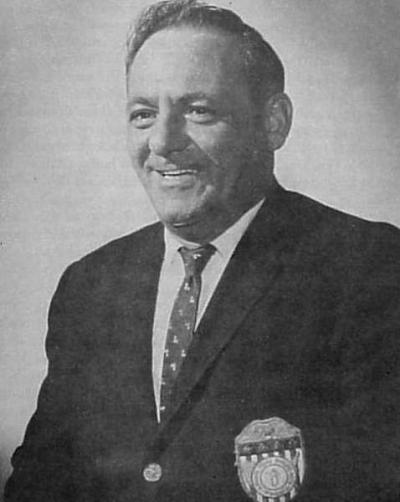
Sleepy Hollow’s population in its first census in 1960 was just 311. “And we got together,” said Janet Oatman. “There was a real pioneer spirit in those days, because there were so few people, and you knew everybody in your unit, and everybody was new to the community. When you moved in, people came to call, from a long ways away. They came to see you. They had Christmas parties, and everybody was invited, and everybody went. They may have had nothing in common except the fact they all lived there, but they were willing to accept that as a common bond, and it was very neighborly. There were block parties. Except they weren’t really block parties, they were unit parties. Sleepy Hollow was developed in units, and you were known by the unit you lived in. For years we’d say we lived in Unit 10. And even in Dundee people knew where that was. There was no real focal point in a community like that, except the Sleepy Hollow Swim Club, and the club became very important as a center of social life, and it gave us all some sense of civic identity.”
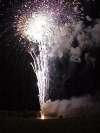
Sleepy Hollow existed as an unincorporated subdivision until 1958 and some residents argued for annexation to West Dundee. “But Falese convinced enough people that taxes would be beyond reason,” said Carl Hoelzer, “and that they’d be forced to install sewer and water at great cost.” A referendum was finally held on March 12, 1958, with low turnout, and the residents voted 40 to 6 to incorporate as the village of Sleepy Hollow. Thus the Three Towns became Four Towns. Falese on April 9th was elected village president, a post he held until his death in 1970, and Lawrence J. Sabatino (shown on left) became the village’s second police chief. A court order officially incorporating Sleepy Hollow was signed by Judge Charles Seidel on April 29, 1958. Since Falese’s death in 1970, there have been six village presidents: Hugh McGowan, James Covey, Carol Schoengart (who, incidentally, was the first woman to serve as a village president in Dundee Township), Theresa Peterson, Robert Shields, and Stephan K. Pickett
Sleepy Hollow’s greatest growth occurred during the 1960’s and its population by 1970 had reached 1,729. Population in the 1980 census was 2,000, Population in 1990 was 3241, and Population in the 2000 Census was 3553, Today (2005 estimate) it is 3,695.
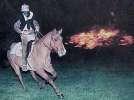
There is no business or industry in Sleepy Hollow. It is strictly a residential community, and, except for a handful of municipal employees, all of its workers are, therefore, commuters. Some residents say this has resulted in a curious lack of communal focus as there is no Main Street where the townspeople can meet and mingle as fellow citizens. But there has been a group of citizens who from 1961 to 1983 published a lively newsletter, keeping citizens abreast of social and civic functions in the community. And in 1973 a very active Sleepy Hollow Men’s Service Club was organized. It has sponsored a variety of programs, including Fourth of July celebrations, spring dances, halloween parades and bonfires after which the Headless Horseman rides through the village, Easter egg hunts, Octoberfests, and teen dances. The popular Fourth of July celebration is a day-long family celebration. Beginning in the morning with a fishing derby, it includes numerous games, contests, food, a parade, and a revue by the Imperial Scots. The evening fireworks display is well-known, attracting many people from the surrounding communities. In addition, parents find a common interest in the Sleepy Hollow Elementary School. In the summer friends meet around the swimming pool, a common gathering place.
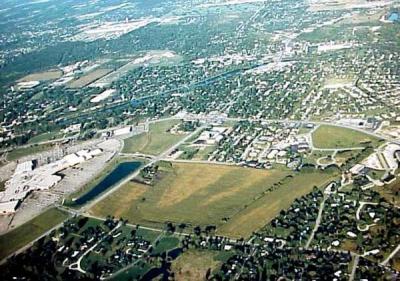
Beyond this, over the years, many residents say they have come to regard their village, not as an isolated enclave, but as part and parcel of the larger Dundee community – especially since increased residential and commercial development has served to physically and psychologically link Sleepy Hollow to the other Three Towns. Asked where they come from, many will simply say, “I’m from Dundee.” While they’re happy with their countrified style of living, however, some of those who migrated from Old Dundee will tell you, with a twinge of guilt, that they still feel they have somehow “left town and moved away.” And when they open their tax bills, inflated by the absence of business and industry, some argue anew for annexation to West Dundee. At this writing, however, they remain a distinct minority, and most seem to feel it is worth the price to live in peace and serenity in “one of the quietest places in the world.”
Floyd Falese, who began it all, died at the age of 51 in St. Joseph Hospital in Elgin on March 8, 1970. He was survived by his widow, Jacqueline; two daughters, Paulette Dohring of Dundee and Sharon Falese at home, one brother, Thomas Falese of Carpentersville; three sisters, Carmella Sorce of Carpentersville, Stella Generalli of West Dundee, and Mary Caporale of Chicago; and grandchildren.
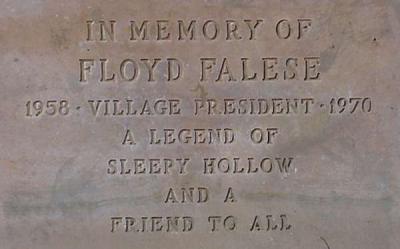
Grateful citizens of Sleepy Hollow dedicated a memorial to their founding father the following Fourth of July, near Lake Sharon on Thorobred Lane, and David Oatman said of him: “He had a lot of chutzpah. He had a lot of guts. He had a lot of moxie. He was a guy who started with nothing. He was running hard the whole time, working hard to make Sleepy Hollow go. He was a local boy, and I think he took a great amount of personal pride in what he was doing. So there was a lot of ego behind Sleepy Hollow. Falese wanted to do a good job. And you’d have to say he succeeded.”
Extracted from Dundee Township 1835-1985,
Dupre, Bullinger, Braden.
Copyright Dundee Township Historical Society, 1985
ISB-0-916445-12-7
Used by written permission
Please Note: Most of the History shown here was written over 25 years ago, some things may have changed since Sleepy Hollow was 25 years old.
